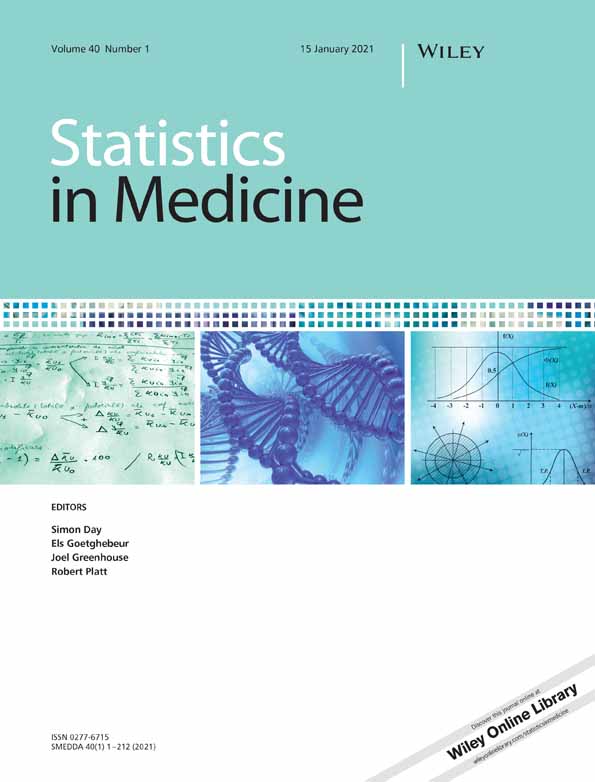Reflecting on “A Statistician in Medicine” in 2020
Walter Dempsey
Department of Biostatistics, University of Michigan, Ann Arbor, Michigan, USA
Institute of Social Research, University of Michigan, Ann Arbor, Michigan, USA
Search for more papers by this authorCorresponding Author
Bhramar Mukherjee
Department of Biostatistics, University of Michigan, Ann Arbor, Michigan, USA
Correspondence Bhramar Mukherjee, Department of Biostatistics, University of Michigan, Ann Arbor, MI.
Email: [email protected]
Search for more papers by this authorWalter Dempsey
Department of Biostatistics, University of Michigan, Ann Arbor, Michigan, USA
Institute of Social Research, University of Michigan, Ann Arbor, Michigan, USA
Search for more papers by this authorCorresponding Author
Bhramar Mukherjee
Department of Biostatistics, University of Michigan, Ann Arbor, Michigan, USA
Correspondence Bhramar Mukherjee, Department of Biostatistics, University of Michigan, Ann Arbor, MI.
Email: [email protected]
Search for more papers by this authorAbstract
In this commentary, we revisit Sir Austin Bradford Hill's seminal Alfred Watson Memorial Lecture in 1962 through the eyes of two practicing biostatisticians of the current era. We summarize some eternal takeaway messages from Hill's lecture regarding observations and experiments translated through the modern lexicon of causal inference. Finally, we pose a series of questions that we would have liked to pose to Sir Austin Bradford Hill if he were to deliver the lecture in 2020.
References
- 1Orwell G. Politics and the English Language. London, England: Penguin Classics; 2013.
- 2Clark RP. One great moment; 2018. [Online] Accessed March 01, 2018.
- 3Little RJ. In praise of simplicity not mathematistry! ten simple powerful ideas for the statistical scientist. J Am Stat Assoc. 2013; 108(502): 359-369.
- 4Adhanom T. WHO director-general's opening remarks at the media briefing on COVID-19 - 11 March 2020; 2018. [Online]. Accessed March 11, 2020.
- 5Hill AB. Observation and experiment. N Engl J Med. 1953; 248(24): 995-1001. https://doi.org/10.1056/NEJM195306112482401.
- 6Spirtes P, Glymour C, Scheines R. Causation Prediction and Search. 2nd ed. New York, NY: Springer-Verlag; 2000.
- 7Pearl J. Causality: Models, Reasoning and Inference. 2nd ed.
Cambridge, MA:
Cambridge University Press; 2009.
10.1017/CBO9780511803161 Google Scholar
- 8Rubin D. Bayesian inference for causal effects: the role of randomization. Ann Stat. 1978; 6(1): 34-58.
- 9Imbens G, Rubin D. Causal Inference for Statistics, Social, and Biomedical Sciences: An Introduction.
New York, NY:
Cambridge University Press; 2015.
10.1017/CBO9781139025751 Google Scholar
- 10Hernán M, Robins J. Causal Inference: What If. Boca Raton, FL: Chapman & Hall/CRC; 2020.
- 11Hill AB. Suspended judgment. memories of the British streptomycin trial in tuberculosis. the first randomized clinical. Trial. 1990; 11(2): 77-79.
- 12Rothwell P. External validity of randomised controlled trials: “To whom do the results of this trial apply?”. Lancet. 2005; 365(9453): 82-93.
- 13Dahabreh I, Robertson S, Steingrimsson J, Stuart E, Hernán M. Extending inferences from randomized trial to a new target population. Stat Med. 2020; 39(14): 1999-2014.
- 14Martens E, Pestman W, Boer dA, Belitser S, Klungel O. Instrumental variables: application and limitations. Epidemiology. 2006; 17(3): 260-267.
- 15Greenland S. An introduction to instrumental variables for epidemiologists. Int J Epidemiol. 2000; 29(4): 722-729. https://doi.org/10.1093/ije/29.4.722.
- 16Davies NM, Holmes MV, Davey Smith G. Reading Mendelian randomisation studies: a guide, glossary, and checklist for clinicians. BMJ. 2018; 362: k601. https://doi.org/10.1136/bmj.k601.
- 17Lawlor DA, Harbord RM, Sterne JAC, Timpson N, Davey Smith G. Mendelian randomization: using genes as instruments for making causal inferences in epidemiology. Stat Med. 2008; 27(8): 1133-1163. https://doi.org/10.1002/sim.3034.
- 18Shi X, Miao W, Tchetgen ET. A selective review of negative control methods in epidemiology. Curr Epidemiol Rep. 2020: 1-13.
- 19Robins JM, Rotnitzky A, Scharfstein DO. Sensitivity analysis for selection bias and unmeasured confounding in missing data and causal inference models. In: ME Halloran, D Berry, eds. Statistical Models in Epidemiology, the Environment, and Clinical Trial.
New York, NY:
Springer; 2000: 1-94.
10.1007/978-1-4612-1284-3_1 Google Scholar
- 20Jun SJ, Lee SS. Causal inference in case-control studies. papers; 2020. arXiv.org.
- 21Hill SAB. The environment and disease: association or causation? Proc R Soc Med. 1965; 58(5): 295-300.
- 22Krieger N, Smith G. The tale wagged by the DAG: broadening the scope of causal inference and explanation for epidemiology. Int J Epidemiol. 2016; 45(6): 1787-1808.
- 23Phillips C, Goodman K. The missed lessons of Sir Bradford Hill. Epidemiol Perspect Innovat. 2004; 1(3): 1–5.
- 24Gail MH. Statistics in action. J Am Stat Assoc. 1996; 91(433): 1–13.
- 25Greenhouse SW, Greenhouse JB. Cornfield Jerome. Encyclopedia of Biostatistics. 2005: 1–5.
- 26Benjamin DJ, Berger JO, Johannesson M, et al. Redefine statistical significance. Nat Hum Behav. 2018; 2: 6-10.
- 27Wasserstein RL, Lazar NA. The ASA statement on p-values: context, process, and purpose. Am Stat. 2016; 70(2): 129-133.
- 28 National Academies of Sciences, Engineering, and Medicine. Reproducibility and Replicability in Science. Washington, DC: The National Academies Press; 2019.
- 29Imbens G. Potential Outcome and Directed Acyclic Graph Approaches to Causality: Relevance for Empirical Practice in Economics. National Bureau of Economic Research (Working Paper). 2019.
- 30Dawid AP. Causal inference without counterfactuals. J Am Stat Assoc. 2000; 95(450): 407-424. https://doi.org/10.1080/01621459.2000.10474210.
- 31Gelman A. Long discussion about causal inference and the use of hierarchical models to bridge between different inferential settings; 2012. [Online] Accessed July 16, 2012.
- 32Breiman L. Statistical modeling: the two cultures (with comments and a rejoinder by the author). Stat Sci. 2001; 16(3): 199-231. https://doi.org/10.1214/ss/1009213726.
- 33McShane B, Gal D. Statistical significance and the dichotomization of evidence. J Am Stat Assoc. 2017; 112(519): 885-908.




